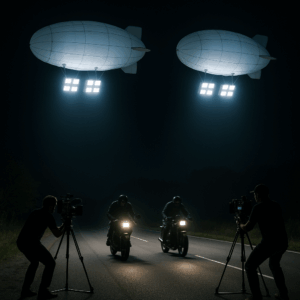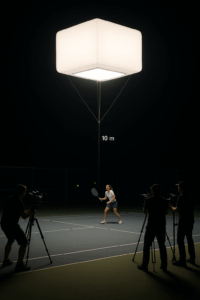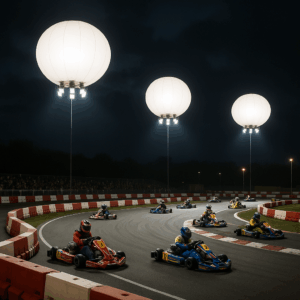Lighting is the silent storyteller in film and television production. It defines mood, sets tone, and directs the audience’s focus. Yet for decades, filmmakers have struggled with the limitations of traditional lighting systems—bulky fixtures, intense heat, long setup times, and the need for extensive rigging. These challenges increase labor demands and reduce creative flexibility on set.
Enter helium balloon LED lights—a radical departure from ground-based systems. By suspending soft, powerful light sources in mid-air, this technology enables smoother workflows, more natural lighting aesthetics, and safer working conditions. These lights are transforming the way directors of photography (DPs) approach both technical and artistic decisions.
At the heart of this innovation is a simple yet powerful concept: using helium to float a lightweight balloon embedded with LED modules. The balloon structure—usually made from durable, fire-retardant nylon or polyurethane—is filled with helium to create lift. Its shape may be spherical, disc-shaped, or ring-like, depending on the lighting distribution needs.
Inside or attached to the balloon are high-efficiency LEDs, which provide soft, omnidirectional light. These arrays are often adjustable in color temperature (from warm 3000K to daylight 5600K) and can deliver consistent color rendering (CRI 95+). Control is achieved through DMX or wireless remotes, and the system can be powered via AC mains, portable battery packs, or generators for remote locations.
Portability and Rapid Deployment
Traditional lights often require heavy stands and crew coordination. Helium balloon LEDs, by contrast, are compact and fast to deploy—often within minutes by a single technician. This makes them ideal for location shoots with tight turnarounds.
Soft and Natural Lighting
The balloon itself serves as a large diffuser, emitting soft, wraparound light that flatters skin tones and creates natural ambient effects. It mimics skylight, making it especially useful for simulating daylight or moonlight.
Shadow-Free Coverage
By floating above the set, these lights eliminate many of the harsh shadows associated with side or bottom-mounted sources. They’re particularly useful in action scenes, group shots, or environments where even coverage is essential.
High Efficiency, Low Power Consumption
LED technology offers impressive brightness with minimal energy use. Combined with low heat output, these systems can operate for extended periods without overheating or requiring additional cooling equipment.
Silent Operation
With no fans or moving parts, helium balloon LEDs are completely silent—ideal for sync sound filming or interviews where background noise must be minimized.
Night Shoots
For nighttime scenes—whether in dense forests, abandoned industrial zones, or bustling cityscapes—helium balloon LEDs provide a consistent overhead glow that mimics moonlight or soft street illumination, perfect for maintaining continuity and visibility across long takes.
Indoor Filming
Inside sound stages, hangars, or makeshift studios, these lights deliver top-down diffusion without cluttering the floor or interfering with camera movement. Their floating presence also opens up more creative blocking and choreography options.
Special Conditions
Over water, in narrow alleyways, or in elevated terrain, helium balloon lights shine—literally—where traditional rigs cannot go. With no need for scaffolding or cranes, they reduce risk and simplify logistics.
Live Broadcasts & Events
Live productions, especially outdoors or on-the-move, benefit from the balloon’s rapid deployment. Lighting designers use them to maintain a soft, photogenic ambiance as stages and performers shift between locations.
In a recent feature film night shoot, a single 3-meter helium balloon LED provided soft top-light across a 50-meter stretch of highway, requiring only two operators and one generator—replacing a truckload of conventional gear.
A variety show filming on location used balloon LEDs to quickly adapt between indoor interviews and outdoor musical performances, eliminating long lighting resets and minimizing shadows cast by handheld cameras.
On the set of a disaster movie, balloon LEDs were rigged to mimic moonlight over a flooded miniature city model. The aerial positioning allowed the director to capture wide angles with realism and depth, all while avoiding glare or hot spots.
| Feature | Traditional Lights | Helium Balloon LEDs |
| Setup & Mobility | Heavy, tripod-based setups | Lightweight, aerial suspension |
| Heat Output | High—requires cooling | Very low—cool to the touch |
| Shadow Control | Limited, often needs flags | Excellent, overhead diffusion |
| Light Quality | Harsh unless heavily diffused | Naturally soft and even |
| Noise | Often includes fans/motors | Completely silent |
| Control | Manual or wired DMX | DMX and wireless remote options |
Weather Dependence
Wind can destabilize helium balloons outdoors. While tethering systems provide some stability, moderate to strong gusts may require anchoring or switching to ground-based alternatives. Weatherproof balloon designs and aerodynamic shapes are now in development.
Helium Supply & Cost
Helium is a finite and increasingly expensive resource. Some manufacturers are exploring air-inflated alternatives with rigid frames or drone-lifted LED rigs that offer similar benefits without the helium dependency.
Battery Life
While LEDs are efficient, longer shoots require high-capacity batteries or hybrid AC/DC power setups. Advances in lithium-ion battery tech and solar-assisted charging are areas of ongoing innovation.
Durability
Repeated inflation and deflation can wear out balloon fabric. Newer materials such as tear-resistant poly blends and reinforced seams aim to improve longevity and reduce maintenance.
Helium balloon LED lighting represents a powerful shift in the visual language of film and television. With their combination of softness, mobility, efficiency, and silent operation, they allow filmmakers to work faster, safer, and more creatively—especially in complex or dynamic environments.
As technological improvements continue—addressing wind stability, helium alternatives, and battery life—helium balloon LEDs are poised to become a staple in every gaffer’s kit, floating confidently into the future of cinematic storytelling.
–The End–
Get in touch for free lighting customization